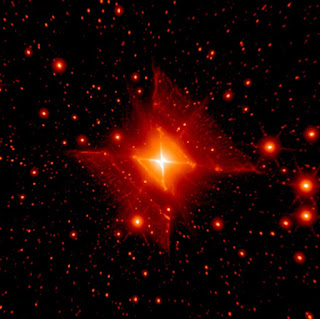At freeastroscience.com, we're committed to unveiling the mysteries of the cosmos in the most informative and engaging ways. Today, we delve into the depths of space to explore an extraordinary phenomenon that continues to baffle astronomers: the Red Square Nebula surrounding the star MWC 922. Located 5,000 light-years from Earth, MWC 922 presents an end-of-life spectacle, ejecting copious amounts of gas to form a nebula with a nearly perfect symmetrical square shape—a rarity in the universe.
The Enigmatic Shape of MWC 922's Nebula
Unlike the typical nebulous formations we're accustomed to, the Red Square Nebula—its name as straightforward as it is unimaginative—stands out with its unique geometry. The intriguing image that brought it to fame was produced in 2007, an infrared masterpiece synthesized from data collected by the Hale Telescope at Mount Palomar, California, and the Keck-2 Telescope on Mauna Kea, Hawaii.
The Science Behind the Square
The mystery deepens as we consider the processes that could have led to such an orderly shape in the chaotic expanse of space. The central star of MWC 922 may be a part of a binary system, expelling gas in a symmetrical pattern. Astronomers hypothesize that this gas could be emitted along two opposing cones. Viewed from our specific vantage point on Earth, these cones align to form the striking square shape of the nebula. However, this remains a hypothesis, and the true nature of the Red Square Nebula is yet to be uncovered.
A Cosmic Perspective
It's important to note that our perception of celestial objects is heavily influenced by our position in the universe. Had we observed the Red Square Nebula from a different angle, it's likely we would witness ring shapes akin to those seen in the aftermath of Supernova 1987A in the Large Magellanic Cloud.
The Red Square Nebula serves as a fascinating reminder of the universe's ability to surprise and intrigue us. Its true nature remains shrouded in mystery, but at freeastroscience.com, we're passionate about bringing these cosmic puzzles to light, narrating the story of the stars in a way that captivates and educates. Join us as we continue our exploration of the wonders of the universe, where every discovery is a step closer to understanding the vast tapestry of space.
Credit: The captivating imagery of the Red Square Nebula is courtesy of the diligent work by Peter Tuthill from Sydney University and James Lloyd from Cornell University, whose contributions in the field of astronomy have been invaluable.


After analyzing the light it will be interesting to see if the is a sort of polarizing effect upon it in the intervening space.
ReplyDeletePost a Comment